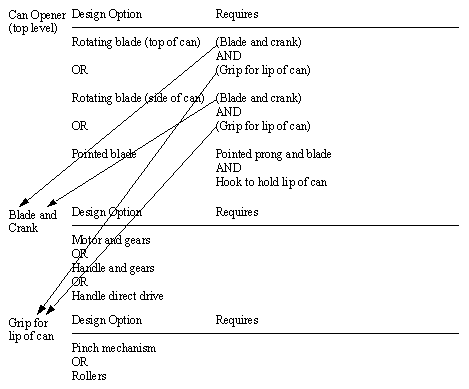
The nature of a design is that it is a collection of decisions. These choices can be high or low level, but they are all coupled. A simple example of a can opener design is shown in Figure 2. Three common designs are detailed, first a rotating blade that cuts on the flat top of the can. A second option is a rotating blade that cuts beside the lid on the outer cylinder of the can. The third option is a tool that pierces the flat top of the can and then uses a prying motion to cut the lid. For each of these design choices there are related sub decisions. In the simplest case (the pointed blade) the design subcomponents are listed, but no sub components are given. The two rotating blade designs need a mechanism to drive the blade, and a second mechanism to move the blade in or out of contact with the can. Parenthesis are used to indicate required parts that are expanded farther, in this case ‘Blade and crank’ and ‘Grip for lip of can’. These two choices are relatively similar so they are reused instead of creating redundant components. Practically the motor and gears should be expanded, but is not in this example for brevity.

Figure 2 - A Model of Design Decisions
In the tables there are a few items that are both required, these are marked with AND. In other cases choices are available, alternates are marked with ORs. It goes without saying that alternates (ORs) are good to have in any design as a fail-safe or backup. The decision to stop is somewhat arbitrary - a good rule of thumb is that you can stop at purchased components, or parts you can already make. Anything that is unknown should be expanded.
The process to create the design tables is,
1. Identify critical choices in the design. These are normally high level strategic, or low level decisions that are technology limited. Each of these will be a table.
2. Begin to add design choices to the tables. If there are low level tables (technology limited), they should eventually link to the upper level choices.
3. Look at the table to find places without alternates - unless they are very low risk alternates should be added.
4. Look for low level tables that are still vague or require more detail. Are the lowest level options something that can be purchased, or is already made in-house?
These tables can be captured in a spreadsheet, or drawn as a tree. This is very helpful in the next stage when risks are considered.
[an error occurred while processing this directive]